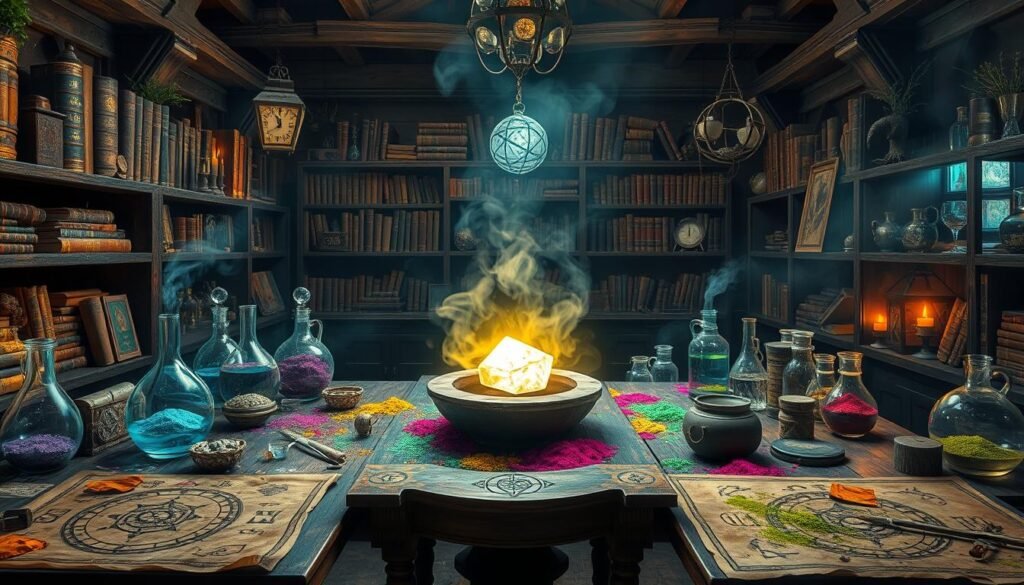Imagine an ancient practice that could change everything. , dating back thousands of years, has always fascinated us. It mixed science, philosophy, and the quest for change, creating a unique path. This path included searching for the philosopher’s stone and understanding deep secrets.
Exploring alchemy reveals a world of symbols, growth, and change. Its history and impact on today’s fields like psychology are huge. still draws people who want to learn and grow, both physically and spiritually.

Key Takeaways
- Alchemy is an ancient practice that combines scientific knowledge with spiritual and mystical beliefs.
- The philosopher’s stone is a central concept in alchemy, believed to possess immense power and the ability to transform metals and the human spirit.
- Alchemy’s influence extends beyond history into contemporary fields such as psychology, symbolism, and personal transformation.
- Swiss psychiatrist Carl Jung drew upon alchemical symbolism to develop his theories of individuation and the integration of the psyche.
- Alchemy continues to inspire those seeking knowledge and transformation, with its unique blend of spiritual and material pursuits.
The Origins and Evolution of Alchemy Through History
has been around for thousands of years, starting in many cultures worldwide. The history of alchemy is filled with stories from ancient Egypt to medieval Europe. Each society added its own piece to the puzzle of alchemy.
Important figures like Isaac Newton, Paracelsus, and Abū Mūsā Jābir ibn Ḥayyān shaped . They worked hard to turn common metals into gold, find cures for diseases, and live forever.
- Ancient Egyptian origins, where chemical knowledge likely arose from mummification procedures and beliefs in immortality
- Greek and Roman influences, which introduced new concepts and techniques to the field of alchemy
- Islamic Golden Age contributions, which saw significant advancements in medieval alchemy and the development of new compounds and reactions
Alchemy grew and branched out, especially in Chinese Taoist traditions. The 8th Century brought to the West. This change led to modern chemistry and the ongoing quest for immortality and metal transformation.
Understanding the Core Principles of Alchemy
Alchemy is based on alchemical principles that guide its practice and philosophy. Philosophical alchemy aims to understand matter and the universe. It seeks to transform and perfect them. The alchemy philosophy believes in interconnectedness and a hidden pattern in existence. To truly understand alchemy meaning, one must explore these principles deeply.
The Three Principles of Alchemy are Salt, Sulphur, and Mercury. They represent the body, soul, and spirit. These principles are key to understanding matter and the universe. They guide the transformation and transmutation process. By grasping these principles, alchemists unlock the secrets of philosophical alchemy and gain insight into the alchemy philosophy.
- Salt: represents the body and the physical world
- Sulphur: represents the soul and the realm of emotions and desires
- Mercury: represents the spirit and the realm of thought and intellect
Understanding these principles helps alchemists grasp the alchemy meaning. They see how it connects to the world around them.
The Four Classical Elements in Alchemical Practice
Alchemical practice uses the four classical elements: earth, water, air, and fire. These elements are more than just physical things. They are also spiritual and philosophical, key to the Great Work. Understanding how these elements work together is vital for alchemical transformation.
Many ancient cultures, like Greece, recognized these elements. The philosopher Empedocles first suggested them. Each element has its own special qualities, important for .
Earth: Foundation of Matter
Earth is the base of all matter, giving it stability and shape. It is dry and cold.
Water: The Universal Solvent
Water can dissolve and change things. It is wet and cold.
Air: The Breath of Life
Air is vital for growth and change. It is wet and warm.
Fire: The Transformative Force
The elements change through qualities like heat. Alchemists focused on three main elements: Sulfur, Mercury, and Salt. These are crucial for changing one element into another.
| Element | Qualities |
|---|---|
| Earth | Dry, Cold |
| Water | Wet, Cold |
| Air | Wet, Warm |
| Fire | Dry, Warm |
Decoding Ancient Alchemical Symbolism
Alchemy symbolism is a complex and fascinating topic that has been studied for centuries. Symbols like the Three Primes and the Four Classical Elements were used to share esoteric knowledge. These symbols were often veiled in secrecy, requiring a deep understanding to decipher.
Some key alchemical symbols include the symbols for the Seven Planetary Metals, like gold, mercury, and silver. These symbols connect celestial bodies, days of the week, and specific organs in the body. For example, gold’s symbol is a stylized sun with rays, representing perfection and the goal of turning lead into gold.
Philosophical alchemy is deeply rooted in alchemical symbols and esoteric knowledge. Alchemists believed these symbols held the key to unlocking nature’s and the universe’s secrets. By studying these symbols, alchemists could gain insight into the universe’s fundamental principles and the human condition.

Key principles of alchemical symbolism include the Three Primes: mercury, sulfur, and salt. These principles were believed to represent the fundamental forces of nature and the human condition. Mercury was associated with the mind and a state transcending death, while sulfur represented dryness, heat, and masculinity. Salt, on the other hand, represented the body and physical matter.
By understanding and decoding these alchemical symbols, we can gain a deeper insight into philosophical alchemy and esoteric knowledge. This knowledge can help us unlock nature’s and the universe’s secrets, and gain a deeper understanding of the human condition.
The Philosopher’s Stone: Ultimate Goal of Alchemical Pursuit
The philosopher’s stone is key in alchemy. It’s seen as a powerful substance that can change metals and spirits. Alchemists thought it could turn common metals into gold or silver, known as “the tincture” and “the powder.”
Creating the philosopher’s stone was the main goal of alchemy. This was called the Magnum Opus, or “Great Work.” It was seen as a huge challenge that needed a lot of effort and patience. The first written records of the philosopher’s stone go back about 4000 years.
Historical figures like Albertus Magnus and Paracelsus believed in the philosopher’s stone. It has also appeared in books and movies, like “Harry Potter and the Philosopher’s Stone” and “The Alchemist” by Paulo Coelho. The philosopher’s stone is a symbol of change and spiritual growth.
| Concept | Description |
|---|---|
| Philosopher’s Stone | A legendary substance believed to possess immense power and the ability to transform metals and the human spirit. |
| Transmutation | The process of changing one substance into another, often associated with the creation of the philosopher’s stone. |
| Alchemy Experiments | Practical applications of alchemical principles, often focused on the creation of the philosopher’s stone. |
Famous Alchemists and Their Contributions
Many people have shaped alchemy history over time. Notable famous alchemists like Nicolas Flamel, Mary the Jewess, and Albertus Magnus have greatly influenced medieval alchemy.
These alchemists sought the philosophers stone through experiments. They recorded their findings in detailed books. Their work has expanded our knowledge of alchemy history and inspired others.
Looking into their lives shows their deep passion for nature and the universe. From Jabir ibn Hayyan to Isaac Newton, alchemy history is rich and diverse. It combines knowledge from many cultures and fields.
Some key famous alchemists and their achievements are:
- Zosimus, a Greek alchemist who compiled a 28-volume encyclopedia on the subject
- Geber, who popularized the idea of combining mercury and sulfur to create gold
- Albertus Magnus, a German monk and practicing alchemist who closely followed Aristotle’s works
By exploring the lives and works of these famous alchemists, we learn more about alchemy. We see the big impact they’ve had on our understanding of the subject.

Laboratory Practices in Traditional Alchemy
Traditional alchemy used many laboratory practices. Alchemists used tools like crucibles, flasks, and alembics. They also used processes like distillation, sublimation, and crystallization to change materials.
Crucibles, flasks, and alembics were common in alchemical labs. Distillation was key, using cucurbits, alembics, and lutes. Alembics helped separate substances, and lutes sealed joints.
Basic Processes and Operations
Alchemists did many things, like heating, cooling, and mixing. They used retorts for distilling dry materials. Fire was important for heating and distillation.
Alchemists spent a lot on tools. They designed, built, and maintained them for their work.
Safety Precautions
Alchemical processes could be dangerous. Safety was crucial. Alchemists had to handle flammable substances carefully and use equipment safely.
Wearing protective clothes and working in well-ventilated areas were key. Alchemists also had to be aware of risks and take steps to avoid them.
| Equipment | Use |
|---|---|
| Crucibles | Heating and mixing substances |
| Alembics | Separating substances |
| Retorts | Distilling dry materials |
Learning about alchemy’s lab practices and safety shows its importance. It highlights alchemy’s role in modern science and chemistry.
The Hermetic Principles and Philosophy
The search for the universe’s deepest secrets is key to hermeticism. It is based on the hermetic principles. These principles, found in the Kybalion, help us understand the universe and our role in it. The seven principles, like correspondence and vibration, apply to both the physical and spiritual worlds.
In philosophical alchemy, these principles guide the process of changing base metals into gold. They also help in achieving spiritual growth. The alchemy philosophy believes that everything in the universe is connected. By understanding these connections, we can learn more about the world and ourselves.
- The principle of correspondence, which states that there is a correspondence between the macrocosm and the microcosm
- The principle of vibration, which states that everything in the universe is in a state of vibration
- The principle of polarity, which states that everything in the universe has its opposite
These principles are the foundation of Hermetic philosophy. They guide the practice of alchemy.
The Hermetic principles are a powerful tool for understanding the universe and our place within it. By applying these principles, we can gain a deeper understanding of the world and achieve spiritual transformation.
Alchemy’s Influence on Modern Science
Alchemy has deeply influenced modern science, especially in chemistry and metallurgy. Alchemists worked to transform and perfect matter. This work helped pave the way for later scientific breakthroughs. Historians like Bruce T. Moran and Ferdinando Abbri show that alchemy was a real science that shaped chemistry. Famous figures like Isaac Newton and Robert Boyle were influenced by alchemy.
The link between alchemy and chemistry is intricate. Many alchemical ideas and methods shaped modern chemistry. For instance, the corpuscularian theory, which says matter is made of tiny particles, comes from alchemy. Scientists like Boyle and Newton built on this idea to understand matter.
Key Areas of Influence
- Chemistry: Alchemical theories and processes, such as the concept of the four classical elements, influenced the development of modern chemistry.
- Metallurgy: Alchemists developed new techniques for extracting and purifying metals, which laid the groundwork for modern metallurgy.
- Psychology and Spirituality: Alchemical symbolism and principles have been adopted in modern psychology and spirituality, with many practitioners drawing on alchemical ideas to inform their work.
- Alternative Medicine: Alchemical practices, such as the use of herbal remedies and other natural substances, have influenced the development of alternative medicine.
Recent studies have shown alchemy’s big role in modern science. By looking at the history of chemistry and metallurgy, we learn how alchemy has shaped our world. This shows the surprising ways alchemy has influenced us today.
Modern Applications of Alchemical Wisdom
Today, modern alchemy is not just in history books. It’s also in fields like psychology, symbolism, and personal transformation. Alchemy’s wisdom helps us grow spiritually and understand ourselves better.
Vaccines and treatments that help us live longer show alchemy’s influence. Alchemical wisdom also shaped modern chemistry. It helped create the first periodic table, using Earth, Water, Air, and Fire.
- Carl Jung used alchemy to study the mind, linking spiritual alchemy to psychoanalysis.
- Alchemical symbols and themes are used in astrology and tarot today.
- Alchemy also shaped alternative medicine and holistic health.
In summary, alchemical wisdom still shapes our world. It impacts personal transformation, spiritual growth, and science and medicine. As we delve deeper into alchemy, we might find new ways to use its wisdom today.
Conclusion: The Enduring Legacy of Alchemy in Today’s World
As we wrap up our journey into the world of alchemy, it’s obvious that it has made a lasting impact. This ancient art has shaped our view of the world and our own growth. It has influenced both science and esoteric knowledge in profound ways.
The alchemical tradition is rooted in ancient wisdom. It offers a holistic view of the universe, filled with symbolism. Today, its legacy is seen in chemistry, metallurgy, and the study of the mind-body-spirit connection in modern alchemy.
Our fascination with alchemy shows our deep desire to understand the world and ourselves. Alchemy teaches us that true knowledge balances the physical and the spiritual. It reminds us that understanding often requires seeing both sides.
FAQ
What is alchemy?
Alchemy is an ancient practice that mixed science, philosophy, and the quest for change. It has captivated people for centuries. It started in ancient Egypt, Greece, and Rome and has shaped modern thinking.
What are the origins of alchemy?
Alchemy began in ancient Egypt, Greece, and Rome. It grew during the Islamic Golden Age. It’s a mix of knowledge from different cultures.
What are the core principles of alchemy?
Alchemy focuses on transmutation. This means changing things, not just metals into gold. It’s also about personal growth and enlightenment. Alchemists saw the world in a special way.
What is the significance of the four classical elements in alchemy?
The four elements – earth, water, air, and fire – are key in alchemy. They stand for the base of things, the universal solvent, life, and change.
How did alchemists use symbolism to convey their knowledge?
Alchemists used symbols and images to share their ideas. This secret language needed deep understanding. It showed both chemical and spiritual ideas.
What is the Philosopher’s Stone?
The Philosopher’s Stone was alchemists’ main goal. It was thought to change metals into gold and the soul.
Who were some of the most influential figures in the history of alchemy?
Famous alchemists include Zosimos of Panopolis and Basil Valentine. They helped grow alchemy’s knowledge and left a lasting impact.
What were the practical aspects of traditional alchemy?
Traditional alchemy used special tools and knowledge. It required skill and safety to avoid danger.
How do the Hermetic principles influence alchemical thought?
Hermetic principles, like correspondence and vibration, guided alchemy. They applied to both the physical and spiritual worlds.
How has alchemy influenced modern science and philosophy?
Alchemy shaped modern science, especially chemistry and metallurgy. Its ideas also influence psychology, spirituality, and medicine today.
How are the principles of alchemy being applied in modern times?
Alchemy’s ideas are used today in personal growth, art, and therapy. Its timeless wisdom continues to inspire and guide us.
Source Links
- https://drismayil.com/post-199/
- https://www.eastonpress.com/all-categories/coffee-table-books/alchemy-and-mysticism-3477.html
- https://www.britannica.com/topic/alchemy
- https://www.chm.bris.ac.uk/webprojects2002/crabb/history.html
- https://aerikarkadian.com/2024/06/20/alchemy-the-three-principles-tria-prima/
- https://naturasophiaspagyrics.com/blogs/alchemy-and-spagyrics/the-three-philosophical-principles-of-alchemy
- https://www.songofstones.com/blogs/metaphysical/the-three-principles-of-alchemy
- https://en.wikipedia.org/wiki/Classical_element
- https://joyvernon.com/alchemy-and-the-four-elements/
- https://blog.prepscholar.com/alchemy-symbols
- https://theconversation.com/deciphering-the-philosophers-stone-how-we-cracked-a-400-year-old-alchemical-cipher-167900
- https://en.wikipedia.org/wiki/Philosopher’s_stone
- https://medium.com/predict/alchemy-unveiled-the-quest-for-the-philosophers-stone-66f530f5cf5a
- https://www.jjcousins.com/post/the-philosophers-stone
- https://en.wikipedia.org/wiki/List_of_alchemists
- https://simonteen.com/2017/08/29/6-magical-alchemists/
- https://www.chm.bris.ac.uk/webprojects2002/crabb/famous.html
- https://studiox.lib.rochester.edu/aurum-vr-an-alchemical-laboratory/
- https://daily.jstor.org/alchemists-workshop/
- https://dilettantearmy.com/articles/alchemy
- https://www.simonandschuster.com/books/Hermetic-Philosophy-and-Creative-Alchemy/Marlene-Seven-Bremner/9781644112885
- https://en.wikipedia.org/wiki/The_Kybalion
- https://www.routledge.com/Hermetic-Philosophy-and-Alchemy/Atwood/p/book/9781138871359?srsltid=AfmBOopt-K298xUac3NFp7xMksAhEh5YeNOsgk18Q9jnyGsjm3Kb6fMG
- https://pitjournal.unc.edu/2023/01/15/lead-to-gold-sorcery-to-science-alchemy-and-the-foundations-of-modern-chemistry/
- https://bigthink.com/the-past/alchemy-dark-ages-science/
- https://medium.com/@harriet2000campbell/unlocking-the-secrets-of-alchemy-how-modern-science-validates-ancient-wisdom-927c73b86cbf
- https://realitysandwich.com/practical-guide-to-alchemy-and-its-modern-day-uses/
- https://medium.com/@newsgroup/alchemy-and-chemistry-bridging-the-divide-between-science-and-mysticism-ea129fa25a40
- https://www.brilliyond.com/blog/history-and-legacy-of-alchemy
Click here to learn more about this topic in a related article.






[…] Click here to learn more about this topic in a related article. […]
[…] Click here to learn more about this topic in a related article. […]